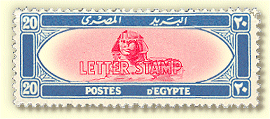

NAAFI Stamps ("Seals") When Egypt increased the postage rate for UPU letters from 15m. to 20m. and for postcards from 10m. to 13m. (November 1st 1931), the special rates to Britain, Dominions and Colonies were also raised. Letters went from 10m. to 15m. and postcards from 8m. to 10m. For letters it was an increase of 50% and the impact was especially severe on the peace-time garrisons in Egypt for the defence of the Suez Canal and other reasons of imperial import, for the homesick troops wrote home a lot and were paid relatively little. Vociferous complaints led to negotiations with Egypt, culminating in an agreement to grant the soldiers the privilege of continuing to enjoy the 10m. rate per 20g when writing to Great Britain and Ireland (but not to anywhere else) (Fig. 1). Neither registration, air mail, nor parcel post was to be allowed, and there was no special rate for postcards. Egypt was to be compensated with a payment of £10,000 the first year and £6,000 for the second year. To qualify for the special rate, which was not to be made available to civilians, a curious scheme was adopted. Qualifying letters were to be identified in three steps: a special stamp ("seal") was to be applied to the back of each letter, a special handstamped frank was to be on the front, and letters had to be posted in military letter boxes, not the civilian ones. The Egyptian authorities provided the franking handstamps, but the British Army provided the special stamps. Thus were conceived the British Forces in Egypt stamps. Stamps The Navy, Army, and Air Force Institute (NAAFI) arranged to have the stamps printed, and took on the task of selling them at the canteens. A design was sketched by Lt. Col. C. Fraser, using the NAAFI seal as the motif, and it was then drawn professionally by Ivor Roberts in ink; this art work still exists. The printing contract was given to Hanbury Tomsett & Co. Ltd. of Willesden, who prepared typographic plates and sent proofs (imperforate, complete, and also without the blue inscription). The stamps were printed in sheets of 80, which were divided into panes of 20 and stapled into booklets of five panes each before delivery. The frame and seal were printed in red and the inscriptions in blue; the perforation was 11 and the paper unwatermarked. There was but one printing, of 500,000. Although these stamps were reasonably P,,conably casual examination to .. copy to be allotted to its position in a pane of 20. However, the relative positions of the four panes in the sheet have not been described although a proof imperforate sheet of four panes was in the Stanley Gibbons auction catalogue for June 25-27, 1997. Hobbs1 has described the plating characteristics in detail. Less than a year later the inscription was revised from POSTAL SEAL to LETTER SEAL (Fig. 2). The choice of these words was probably in deference to the reluctance of Egypt to condone postage stamps of another power being sold on its soil. The revised stamps were issued in August 1933. 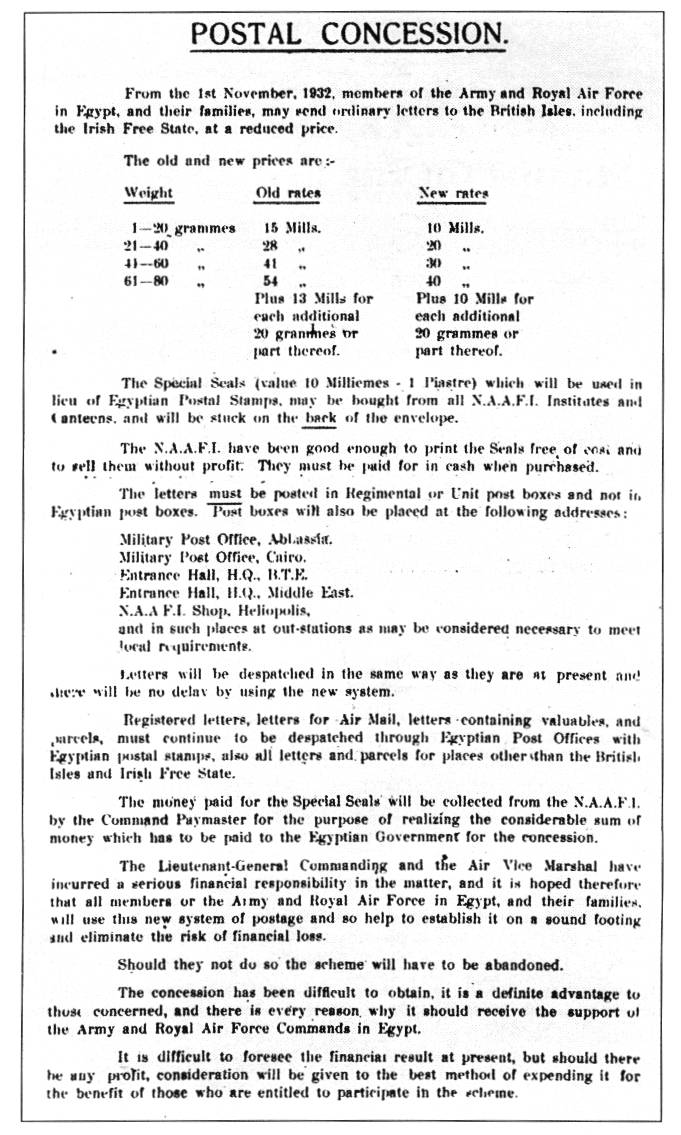 Fig.1 The Postal Notice announcing the concession 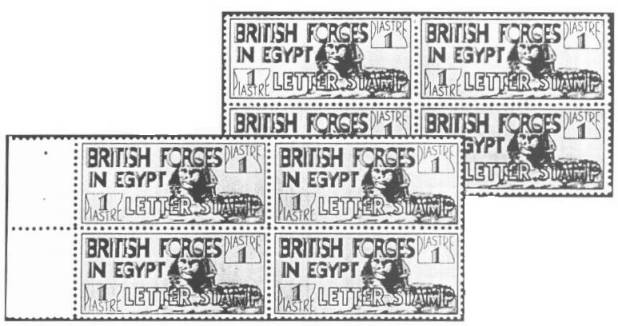 Fig2. The first and second designs. The lower left stamp of the block shows the constant plate flaw, a bump on the left side of the top of the second I of BRITISH Although the first two stamps were functional, they show little artistic inspiration and it is not surprising that when supplies began to run low a new design was sought Miss Waugh, of Cairo, drew an artistic design having a rendition of the sphinx as background to the lettering and it was sent to Harrison & Sons for printing by photo-gravure (Fig. 3). Plates of 40  Fig. 3 The design of the 1934-1935 stamps, showing omitted perforation hole and corrected version. were used to print 250,000 stamps in rose-carmine which were perforated 14'/2x14. They were stapled into pads of five panes of 20 as before and issued on June 1st 1934. There are enough small plate flaws to allow plating of single stamps (details may be found in Hobbs' book). The small printing was not sufficient to meet the needs for a full year and a new printing was ordered in time for the Christmas mails (issued December 5th 1934). A different colour, green, was chosen, and 250,000 stamps were printed; other details were unchanged. Early in the following year a further printing was required and 405,000 stamps, less 100 destroyed, were issued on April 24th 1935. The color reverted to rose-carmine, but the perforation was new, 131/2x 14. A comb machine was used on which the tines, which produced the vertical perforation, were short by one hole (i.e., they had 13 pins), and made a wide tooth at the bottom of each stamp. The Silver Jubilee of King George V was celebrated philatelically throughout the Empire, and the British Forces in Egypt were not left out. A commemorative overprint, JUBILEE / COMMEMORATION / 1935, was applied to 27,000 stamps specially printed in bright ultramarine. Colour proofs, imperforate and without overprint, were prepared (Fig. 4); their scarcity suggests that only one sheet of 40 may have been made. Although the overprinting was well executed (presumably by Harrison & Sons), there were two constant flaws, one of which is prominent enough to be listed in some catalogs (Fig. 4): a short right leg of the U (Fig. 5) and a slightly elongated N which appears to be narrow. The short U occurs on positions 6 and 8 of half the panes, and the elongated N on positions 14 and 16 of half the panes, and positions 9 and 11 of the other half of the panes. A pin hole or indentation is sometimes seen in a bottom corner and is presumed to be caused by a positioning pin used in the overprinting. An identical overprint in red on the 1 plaster green, and in blue on the 1 plaster red, has been reported (used with retta cancellation); status unknown. 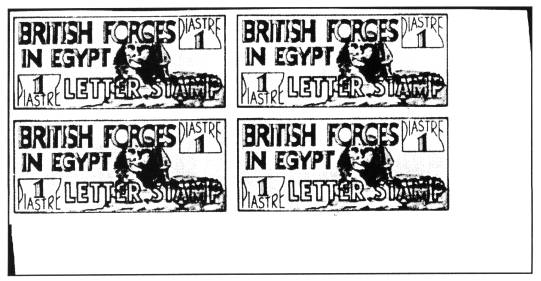 Fig. 4 Imperforate proof in blue The Jubilee stamps were appropriately issued on May 6th 1935. To prevent speculation, sales were restricted to ten stamps per person. First-day covers are very scarce because it was a holiday and the letter boxes were cleared only once, in the morning.The last printing of the British Forces stamps was issued on December 21st 1935. The stamps were the same as the April printing except that a new perforating comb, having 14 vertical pins, was used and there is consequently no wide tooth at the bottom. Of the 500,000 printed, 214,000 were sold and the remainder destroyed. When sales ceased, 50 sets of 24 of souvenir covers (one from each military post office) were prepared for presentation to prominent individuals, including King Fuad.  Fig. 5 The Jubilee overprint, showing short u on lower right stamp. This stamp exists bisected on covers posted at Faggala civil post office and addressed to Kasr el Nil, presumably with the intention of paying the Egyptian civil internal postage of 5m. Curiously, they were accepted, although there was no franking handstamp; the stamps were cancelled with the date-stamp, not the retta. One cannot help suspecting philatelic influence. When the UPU letter rate was raised, so was the rate for printed matter, including greeting cards, becoming 4m. instead of the previous 3m. The agreement included maintenance of the 3m. rate for soldiers, with the same restrictions as for letters. The required 3m. stamp was designed by Sgt. W.F. Lait, who undoubtedly did the best he could, but the result was Egypt's most primitive stamp (Fig. 6), the execution of which makes the Third Issue of ordinary stamps of the 1870s look almost refined. The stamps were lithographed by Walker & Co. Amalgamated Press in Cairo in sheets of 20, perf. 11 ½, in black on unwatermarked paper tinted azure to bluish grey. Proofs of the accepted design arranged tete-beche with an unadopted minor variant were prepared in blocks of four, imperforate; they are quite scarce, but not rare. The number printed is reported to have been 41,857, an odd figure that implies that some were destroyed, or that what is meant is the number sold. They were stapled into pads of five panes. They were put on sale on October 26th 1932 and remained on sale until December 31st, so as to be available for New Year's greetings. The only error variety is double perforation on the left side. How-ever, the crude printing makes it easy to identify every position by means of plate flaws (described by Hobbs). 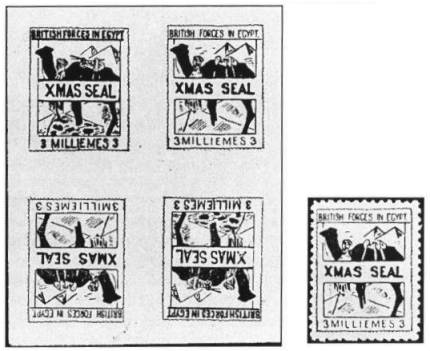 Fig. 6 The accepted design and the unaccepted alternative. The 3m. stamps for the next year were printed from the same stone, but in chocolate on white to toned paper, in a quantity of 53,736. They were issued on November 13th 1933. The issue for the following year was in blue on white paper; 62,865 are reported to have been printed (or sold). Imperforate proofs in the issued colours exist for both the 1933 and 1934 issues (an imperforate sheet of the 3m. blue is illustrated by Hobbs). The stamps were issued on November 17th 1934. In 1935 demand increased owing to an influx of troops occasioned by a show of recklessness by the Italian forces on the western border. Accordingly, 101,100 3m. stamps, printed in red, were issued on November 23rd. Imperforates, presumably proofs, exist. The quantity was even then not adequate and a provisional overprint, "Xmas 1935 / 3 Milliemes", was applied to 10,000 of the 1pi. stamps (Fig. 7). All but 80 were sold by the time a second printing of the 3m. stamp was made available. This was printed in a quantity of only 21,500, which was more than adequate, for only 12,075 were sold. It is easily distinguished from the first printing by the shade, which is paler (some people detect a faintly orange tint). The interim provisional was put on sale on December 16th, but not at all offices. The overprinting was quite well done, but it is not clear who the printer was. It was done in two steps, ten at a time, according to Hobbs, but the two plate flaws that he describes are stated to occur only once on the pane of 20. This fact suggests that the plate was actually made up of two matrix blocks which were not exactly aligned with respect to each other, the printing having then been done in but one step. The plate flaws are: a break in the top of the right leg of the first M in Milliemes (position 13) and two nicks in the right side of the 3 (position 18). 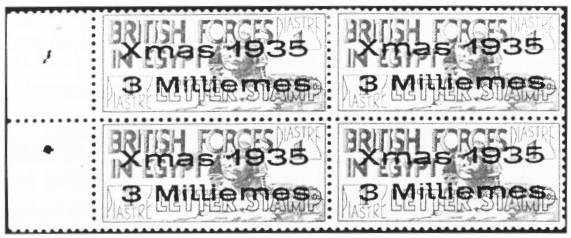 Fig. 7 The XMAS provisional. Cancellations and Use1 The required crowned-circle franking handstamps were normally struck in red, but occasionally in black. Their locations are shown below, but it is not necessary to consult this list to identify a cover because the face of every cover also carries a post office date-stamp.
Number 7 frank ceased being used on March 6th 1933 after just four months and is quite scarce but by no means rare. There are various stories about how it disappeared, all of which may be apocryphal; the explanation that I prefer is that it was trampled by a camel enraged by its unflattering portrayal on the 3m. Christmas stamp! Both military post office and civil post office date-stamps are found on the face of covers, according to how the mail was handled. The MPO date-stamps, with one exception, were of a uniform type, with M.P.O. at top, and the name below, without Arabic equivalent (Fig. 8): ABBASSIA, ABU QIR, ABU SUEIR, ALEXANDRIA, CAIRO, EL DABA `, MERSA (or MARSA) MATRUH)", MOASCAR, PORT SAID (" indicates those I have not seen on a cover with NAAFI stamps, but only Army Post stamps). The exception is the use of the date-stamp inscribed MILITARY / POST OFFICE / ALEXANDRIA with bars above and below the date, a device still on hand after many years of earlier use. Date-stamps of the civil post offices that handled concession mail after it was posted in a military letter box include: Abbassia Barracks, Abu Suwer, Abu Qir, Alexandria, Alexandria-Abu Qir and vice versa, Cairo, Faggala, Heliopolis, Ismailia, Ismailia Camp, Mamura, Marsa Matruh, Port Said, Ras el Tin, and Sidi Gaber.  Fig. 8 Types of MPO date-stamps used. Date-stamps of the civil post offices that handled concession mail after it was posted in a military letter box include: Abbassia Barracks, Abu Suwer, Abu Qir, Alexandria, Alexandria-Abu Qir and vice versa, Cairo, Faggala, Heliopolis, Ismailia, Ismailia Camp, Mamura, Marsa Matruh, Port Said, Ras el Tin, and Sidi Gaber. Five types of retta obliterator have been recorded (all have an outline):
It is commonly difficult or impossible to identify an example with certainty because so many were badly struck. They were generally struck in black, but Abu Sueir (and perhaps other places on occasion) used red; blue and violet have also been seen (scarce).Although the stamps were supposed to be placed on the back of the envelope, senders occasionally put them on the front, out of habit. This aberration seems always to have been tolerated. In some cases the stamp was then actually cancelled by the franking handstamp, in others, the retta was used as well. When a letter was posted directly in a civil post office box, it was a different matter. The stamps were considered to be invalid and were either left uncancelled, with zeros surrounding them, or were scribbled on. Such letters were marked for postage due (Fig. 9). Another situation resulting in postage due was the ignorance of some postal personnel in Britain, who undertook to charge postage due on properly posted letters even though there was no such indication from the origin. Postage due was sometimes charged when letters were sent to disallowed destinations, such as China, but the charge was not always collected.  The Army Post Stamps March 1st 1936 saw a major change in the arrangements for mail from the troops, coinciding with replacement of the NAAFI stamps by formal Egyptian stamps bearing the portrait of King Fuad (Fig. 10). The new stamps were to be sold in the same way, but they no longer needed to be placed on the backs of letters and to be accompanied by a separate franking handstamp. The use of the rettas was done away with and the stamps were consistently cancelled with date-stamps (in unusual situations, however, when a stamp had escaped cancellation at origin, the retta was then used). The old stamps could continue to be used up to March 15th, but holders of large quantities were allowed to cash them in before the new stamps went on sale. Fig. 10 The King Fuad Army Post stamps. A 3m. green stamp in the same design was issued on December 1st 1936 for use on holiday greetings; it was temporarily withdrawn from sale on February 15th 1937, to be placed on sale again in December 1937 until February 1938 and in December 1938 until February 1939. Both of the foregoing stamps were produced by the Survey Department of Egypt by photogravure. They were printed in sheets of 100 on paper watermarked crown and Arabic fa', perforated 131/2x14. The several years of use required four printings of the l0m., having control numbers A/36, A/38, A/38, A/39, and A38 A39 B/39, and one printing of the 3m., having control number A/36 (500,000 are said to have been printed). For each control number "royal proofs" were printed: imperforate on thick paper with Cancelled printed on the back and on gummed and watermarked paper with skewed perforations. The 3m. proofs are obviously four times as scarce as the 10m. It took some time after the death of King Fuad for Army Post stamps showing King Farouk to be provided. The new stamps were issued on December 16th 1939 in the same design as before, but in a smaller size (Fig. 11) and perf. 13½ . 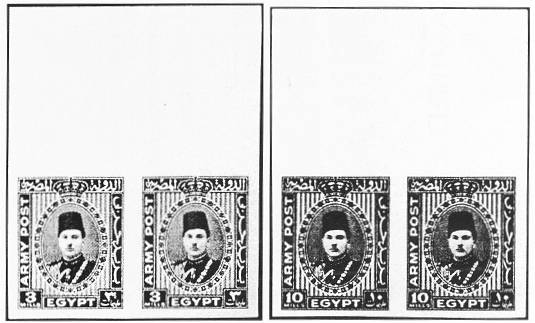 Fig. 11 The King Farouk Army Post stamps. Three printings of the 10m. were made, having control numbers A/39, Cancellations and Use Initially, use of the Army Post stamps was subject to the same restrictions as had applied to the NAAFI stamps. However, with the outbreak of war between Britain and the Axis Powers and the arrival of army and air force contingents from Dominions and Colonies, Army Post stamps were permitted to be used to pay for air mail. The rate was 40m. (a reduction from the civilian rate of 60m.) which could be paid either with four Army Post stamps or a single in combination with a 30m. ordinary stamp (usually the 30m. air mail stamp) (Fig. 12). The restriction of the destination was also removed and many letters franked with Army Post stamps were sent to the several Dominions. 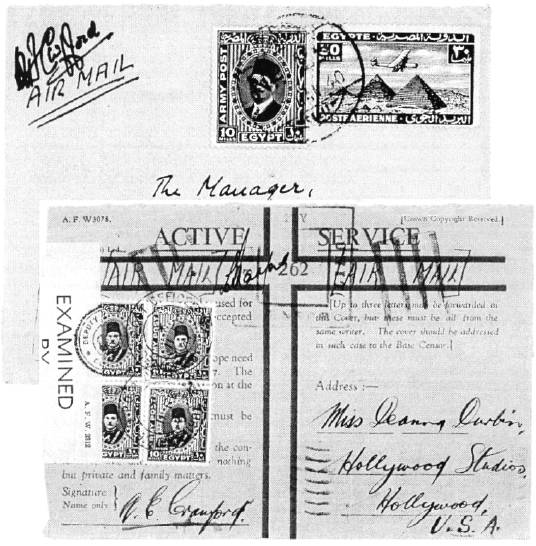 Fig. 12 Use of the Army Post stamps to pay air mail. The requirement that soldiers' letters be posted in military letter boxes to qualify for the reduced rate became an irksome source of confusion when offices began to be moved about as military preparations increased. This resulted in many letters being charged postage due, and consequent to that, many complaints being made. Eventually, the British GPO decided not to charge postage due on Army Post letters, regardless of the office of posting. The stamps of the King Farouk reign did not render the King Fuad stamps obsolete and they continued to be used even into 1941. However, free-franking for surface letters was introduced on November 1st 1940 and thereafter the Army Post stamps were only useful for air mail and possibly for letters to destinations for which the free franking privilege did not apply. The use of the 3m. stamps deserves separate comment. The King Fuad 3m. is somewhat scarce on cover, but it is still easily found, having been used for three seasons. The King Farouk 3m. is another matter. Shortly after it was put on sale it became redundant because of the introduction of surface free franking. Most Christmas greetings would not have been posted until long after November 1st and only those to distant destinations, especially Australia and New Zealand, were posted before then. Consequently, this stamp is truly rare on legitimate covers and is very difficult to find used with a proper cancellation (some were cancelled to order at a later date with Cairo or Field Post Office date-stamps). Besides use on simple greeting cards, there were three other ways in which the stamp could be legitimately used. One was to pay the postcard rate to Egyptian addresses, usually other military stations. Another was to pay the 13m. foreign postcard rate, in combination with a 10m. stamp (I have seen such use to Palestine). Still another was to overpay the 10m. letter rate with four copies of the 3m. The last is not as improbable as it might seem, for the shortage of lm. coins made it necessary to buy 3m. stamps in multiples of five and it was easy to be left with extra ones for which there was no need. I have also seen a cover with air mail paid by three 10m. and four 3m. stamps. The influx of troops in 1939 caused many new military post offices to be opened, with date-stamps brought along with the contingents from Australia, India, New Zealand, and South Africa, or manufactured for them in Egypt. The variety of cancellations to be found on the Army Post stamps is quite large and very interesting, but the subject is better treated in connection with the other military postal markings in Chapter XXXI. Some examples are shown in Figure 13. Censoring, which was put into effect when war began, is taken up in Chapter XL. 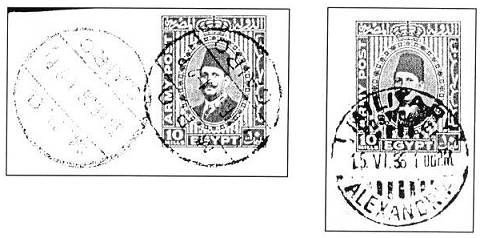 M.P.O. Cairo Military Post Office Alexandria 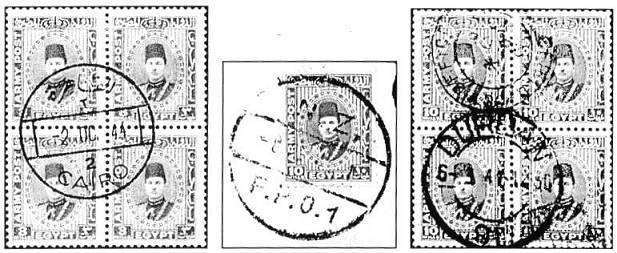 cancelled to order at Cairo N.Z. F.P.O. 1 Field Post Office overstruck with DURBAN 
References 1. J.E.O. Hobbs, British Forces in Egypt Postal Service 1932-1940, 2nd Edition, self-published, Worthing, Sussex, 1984. 2.G.L. Lee, Egypt. Royal Imperorate Printings, self-published, Bernardsville, NJ, 1959. 3.C. Minett and J.A. Firebrace, FPHS No. 51, 1-6 (Sep./Oct. 1961); No. 52, 11-15 (Nov./Dec., 1961). |
|
|